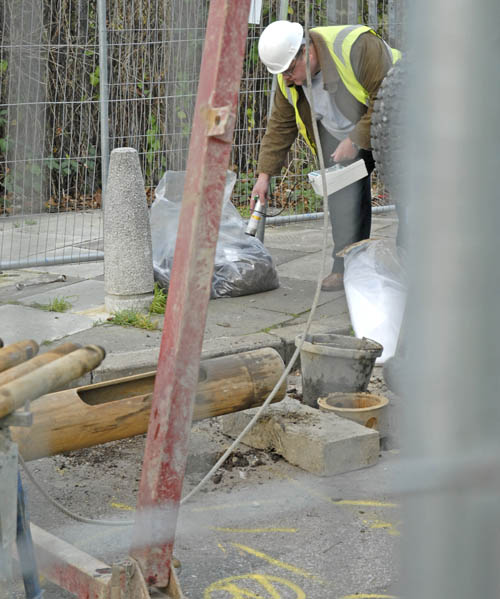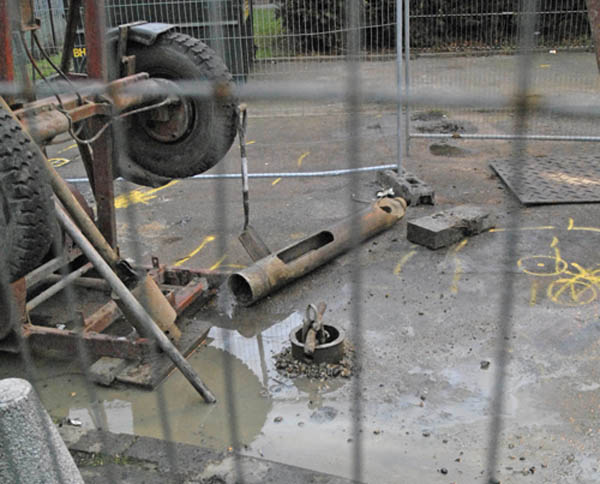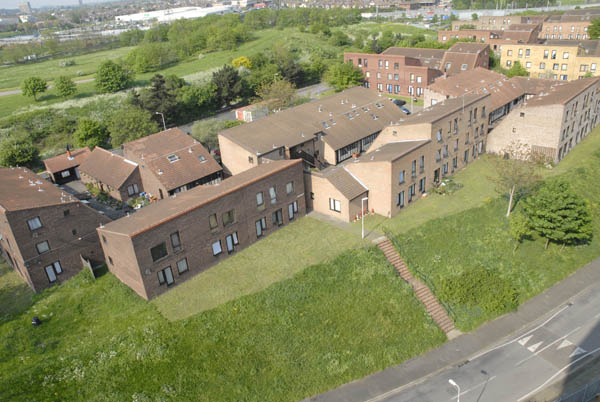Contamination and controversy in the London Olympic Park
Mike Wells | 10.05.2007 14:19 | Ecology | London

LDA worker with giegor counter at drilling on Clays Lane

Water pumped down boreholes left on surfact at Clays Lane

airial view of the Clays Lane Estate in happier (pre Olympic) days
 mikejwells@yahoo.com
mikejwells@yahoo.com Sorry about the copyright, expanation at bottom of page.
We are told the Olympic Park will be the largest construction site in Europe, and with the Olympic Clock ticking relentlessly towards 2012, late delivery of the Olympic project is not an option. On-time delivery is however complicated by many practical and human dimensions, some of which have the capacity to seriously tarnish the brand identity of the Olympics.
The Olympic Park and its surrounding area has, for more than a century, been the home to what one local history book refers to as “obnoxious industries”. At one time the area employed some 7,500 people in the manufacture chemicals. Those chemicals included everything from arsenic to pesticides. This was a different and unregulated era when there were few if any regulations covering the production and dumping of substances, and frequently little knowledge of how dangerous some of these substances were. Agri-chemicals like Agent Orange and DDT, were celebrated and seen as a great leap forward. Other dirty industries included at least two companies working with radioactive materials, as well as a small experimental nuclear reactor run by Queen Mary’s College. Not only is the land some of these factories occupied likely to be contaminated, so are the places their waste was dumped.
Also inside what will be the Olympic Park is an old landfill site, the former Westham Tip. The tip was just a mile or so away from Hemingway & Co and a few miles from Thorium Ltd both of which worked with the radioactive metal, thorium. The factory occupied by Thorium Ltd was demolished some time ago, and 10,000 tonnes of contaminated material from the factory had to be dumped at sea. A report by John Large titled Lost Radioactive Waste of the UK comments that record keeping at Hemingway & Co was inadequate. Not only is it possible that the waste from these companies ended up in the Westham Tip it is also possible that Hemingway’s factory site on Marshgate Lane will be contaminated. John Large who, in a varied career, has also worked with the Argonaut series of experimental reactors of the type used by Queen Mary’s comments that the operation of this type of reactor produced a significant amount of waste. He also suggests that in those unregulated days those that did know how waste should be dealt with were often not responsible for its disposal, and those that were in charge of disposal frequently did not have the knowledge required to deal with the waste satisfactorily. The Radioactive Substances Act 1960, which regulated the dumping of waste did not come into force until 1963. John Large maintains that during the 3 year window before the Act came into force there was an accelerated history of unlicensed and unrecorded dumping. He argues that when the word got round of a place willing to take radioactive waste many organisations took the opportunity to offload material.
Today on the site of the former Westham Tip stands the Clays Lane Housing Estate. A few months ago, under the Freedom of Information (FOI) Act, residents of Clays Lane obtained a document showing that in 1959 radioactive waste was buried in the Westham Tip. They recently obtained a second document under the FOI Act showing that radioactive waste was also buried there in 1953. Also under the FOI Act Clays Lane residents obtained results of a survey carried out by the Environment Agency showing higher than normal levels of thorium in the River Lee, which runs along side the former landfill site. They claim that the London Development Agency (LDA) may have already put their health at risk by bringing dangerous material to the surface when they drilled test bore holes around the estate. They also claim that the LDA’s work on ground (also landfill) adjacent to the estate may pose a risk to health.
Chris Busby who has been acting as an expert witness for Clays Lane comments that …
“if there is documentary evidence of the disposal of Thorium waste at the site, then this has to be taken seriously as Thorium dust represents a serious radiological inhalation hazard. I note that the quantities of Thorium involved do not seem to be known … any attempt to look for the material by drilling random holes and examining material with a Geiger counter will not result in evidence that the material is not there … it would, in my opinion, be unsafe to disturb the soil: the result could involve dispersion of dust which represents a significant hazard to local inhabitants or workers.”
John Large comments that there is likely to be a risk from other non-radioactive contaminants in the former landfill. That assumption seems reasonable as according to a Local History Book, West Ham 1896 to 1986, published by the London Borough of Newham an alarming number of dangerous chemicals were manufactures in the area.
Local industrial historian Chris Seagrave who, in 1958, was just starting his career as a chemical engineer at an oil distilling company, Smith Bros & Co, at 24 Marshgate Lane reminisces that on one side of Smith Bros was Hemingway & Co and that as well as thorium they also produced arsenic. On other side of Smith Bros at 22 Marshgate Lane was a company storing or working with thorium. He tells me that workers at Smith Bros used to joke that if the Arsenic didn’t get you then the Thorium would. Marshgate Lane is inside the Olympic Park and seems to have an industrial history typical of the area.
After 1964, there may have been controls over the dumping of radioactive material, but before to 1974 there were no regulations controlling the dumping of anything non-radioactive, but still potentially lethal. The former West Ham Tip is just the wrong vintage; it was active from before World War 2 until around 1973. As John Large comments it is therefore likely to contain not only the radioactive material already known about, but also many other dangerous substances.
Huge tunnels are currently being constructed under the Olympic Park to take cables that at present hang from pylons and dominate the skyline of the area. Despite the fact that they are 25 metres underground contamination was recently found in the tunnels, the work had to be stopped and workers taken to hospital. A year or so ago I spoke to workers on these tunnels. They were digging through the former Westham Tip, one of the sites designated by the LDA themselves as high risk to human health. The workers I spoke to told me they had not received any training or information that they were digging through potentially contaminated ground.
Another issue is the area’s WW 2 history.
Evidence of the Luftwaffe handiwork is shown on a wartime map of the area, which is literally pockmarked with bombsites represented by small dots. Marshgate Lane alone suffered approximately 6 direct hits. One of those was to Hemingway & Co. It is thought that there are at least two sites within the Olympic Park where material from war-damaged factories was dumped, one of those sites is believed to be the West Ham Tip. The bomb map gives some indication of how much contaminated material must have been dumped. The other WW2 problem is unexploded ordinance, as an internal memo from the Newham notes … “there is the possibility that not all unexploded ordinance has been recorded, especially in the remoter undeveloped parts of the Borough”. Though close to all the industrial activity, the area around Clays Lane remains until today the most undeveloped part of the borough. There is also confusion over the accuracy of these records as the same memo notes … “it is not clear if these reports were continually updated” and the memo goes on to note that … “these records do not tie in with the Health and Safety Executive records”. However an unexploded bomb is recorded as having landed within 50 or so metres Clays Lane, who knows if it is still there?
The decision to carry out invasive works in and around the Clays Lane Estate with residents still living there seems surprising especially when the LDA have themselves designated the area around Clays Lane as potentially hazardous to human health (SEE MAP). On visiting one of the houses at Clays Lane whilst drilling was underway, one could feel the whole building shaking, and it was impossible not wonder what would happen if the drill bit struck an unexploded bomb. The LDA’s contractors used a Geiger counter during the drilling process but according to witness statements their working practices appeared haphazard, and water they had pumped down holes was spilling out over the ground and was left there.
Large scale earth works are required to landscape the Olympic park. Information on the LDA’s website states that it is estimated that there is 175,000 tonnes of hazardous waste that cannot be treated for use on site. This will need to be taken off site for further treatment and or disposal. However the latest planning documents released by the LDA say that approximately 650,000 tonnes of material will have to be taken off site. These figures look very much like to whole Olympic budget in general – increasing. The plan is to remediate as much contamination on site as possible, but whether taken off site, or remediated on site, as Chris Busby says, the problem is that when the ground is disturbed any risk to health is likely to be increased due to the inhalation of dust.
Because of concerns over potential risks to health one resident of Clays Lane has been trying to obtain a court injunction to halt work on the Olympic site near the estate. However the legal action stalled when a strong case for Legal Aid was refused. Bill Parry-Davies, the resident’s solicitor, said “the refusal of legal aid here seems to conflict with the established guidelines for dealing with cases where there is a wider public benefit, namely where other local residents would also benefit from the protection of an injunction to prevent the risk of contamination until they are rehoused elsewhere”. He goes on to note that the Legal Aid Appeal Committee described the case as “thoroughly prepared and forcefully put” and comments the subsequent rejection of the application was “surprising”.
Amongst residents of Clays Lane there has already been speculation over what influence the Olympic project might have over government bodies like the Legal Services Commission? The surprising decision by the Legal Aid Commission in relation to the safety of local residents may be one small indicator of the way things are to be handled in the wake of the Olympic project? As Julian Chayne a Clays Lane resident puts it … “it is astonishing the LDA is prepared to start invasive works on such a tip created at a time when controls were much less stringent, while residents are living next door. They should be operating a precautionary principal and showing proper care for residents.” However at the time of writing work next to Clays Lane continues, trees on the site have been cut down, and surface vegetation stripped away in leaving the uncapped landfill material exposed, and excavations are being carried out all over the site.
The political and financial pressures to deliver on time, makes it plausible that the LDA and politicians may see this as a kind of emergency situation, and that leads to the question of whether standards are to be kept, or corners are to be cut? It is notable that the document referring to waste buried on the site in 1953 was only obtained after an FOI request to the Environment Agency and that this document was not forthcoming from previous FOI requests to Newham Council or the LDA. An article in New Civil Engineer comments that … “contractors have been banned from talking to the press [about contamination] by their client the Olympic Delivery Authority (ODA).” Workers on the site who are currently taking samples from the land but they never know the results as they bagged up and sent off site to laboratories for testing. For the LDA and ODA this is a tricky situation. The issue of contamination has the capacity to seriously damage not only the Olympic brand, but could also cause labour problems and reduce the value of land post-Olympics.
© Mike Wells,
 mikejwells@yahoo.com
mikejwells@yahoo.com
Mike Wells
 e-mail:
mikejwells@yahoo.com
e-mail:
mikejwells@yahoo.com
Comments
Display the following 2 comments